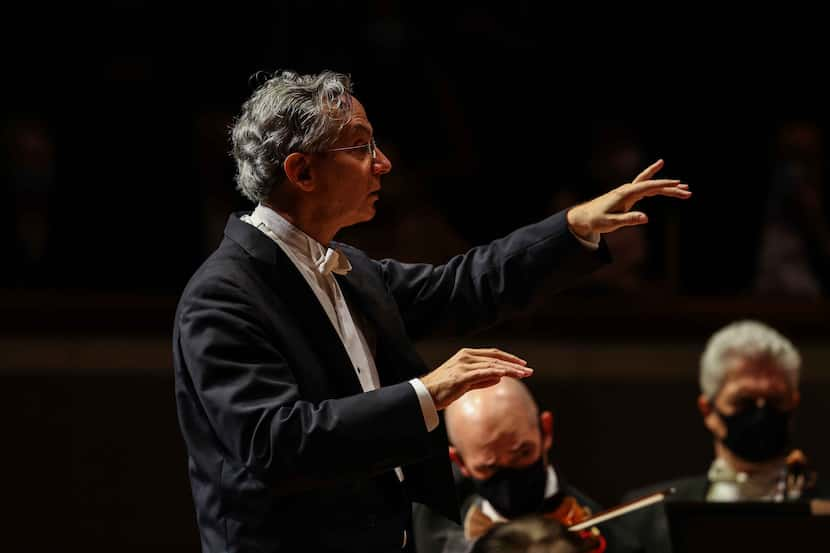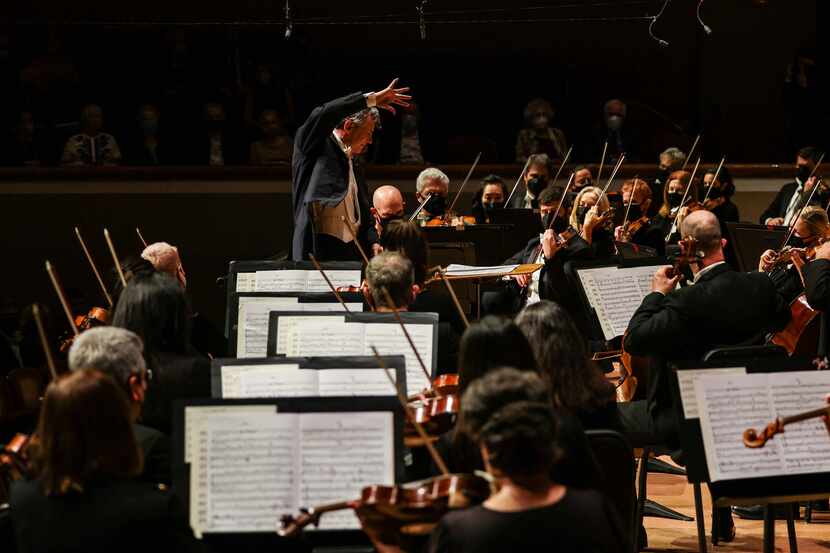Fabio Luisi’s first season as music director of the Dallas Symphony Orchestra, in 2020-21, wasn’t what anyone anticipated pre-COVID-19. The orchestra smartly pivoted, though, to present a full season of concerts that could be played by chamber-orchestra forces — 40 to 50 musicians.
The full orchestra, though, filled the extended Meyerson Symphony Center stage Thursday night. In what felt like the real start of Luisi’s tenure, the opening of the 2021-22 classical season had a tangible emotional charge.
Luisi has promised to program unjustly neglected earlier 20th-century American music, and he opened Thursday’s concert with not one, but two such works.
Frederick Converse (1871-1940) was part of a constellation of mostly German-trained American composers clustered around Boston in the late 19th and early 20th centuries. Composed in 1904, The Mystic Trumpeter is a 20-minute tone poem in five connected sections, inspired by Walt Whitman’s eponymous poem.
Both poem and music imagine a disembodied trumpeter and a dreamy, romantic one, but also a caller to war and a celebrant. Strauss was conducting the opera in Munich when Converse was studying there, and one wonders how much of the German composer’s work the American heard. Certainly there’s much of Strauss in this real showpiece — the dramatic flair, the succulent harmonies, the textural and coloristic riches.
Luisi was at his operatic best here, managing its structure, eloquently shaping the rise and fall of phrases, giving just the right breaths between them, lingering just so before pivotal downbeats.

He also did fine work with Aaron Copland’s Organ Symphony, a piece long overdue in the Meyerson. Copland was all of 24 when he finished the piece, and its fine craftsmanship betokens three years of study with the formidable French pedagogue Nadia Boulanger. Also an organist, Boulanger played its premiere, in New York, in 1925.
There’s little here to suggest Copland’s later Americana. The first movement is mysterious and exploratory, with dreamy wreathings and washes of sound. The central scherzo dances in brash, jazzy rhythms, with a spooky middle section. The finale brings back the mystery, but both organ and orchestra get angry outbursts before a rousing ending.

DSO organist Bradley Hunter Welch played with great flair, exploring everything from mere whispers of sound to seismic assaults from the Meyerson’s C.B. Fisk organ. That he and the orchestra kept together in those tricky rhythms was no small accomplishment.
That Luisi plans to record the four Brahms symphonies with the DSO made Thursday’s performance of the First Symphony doubly frustrating. The middle movements were fine, but the outer movements were often too slow and too loud.
Brahms marks the first-movement introduction “Somewhat sustained.” Surely that means just a little slower than the main allegro. But Luisi’s rather ponderous opening tempo presaged a leaden Allegro that was, at most, moderato. Forced dynamics, in music nowhere marked above a classical fortissimo, made it feel even heavier.
The introduction to the finale was more molto lento (“very slowly”) than the marked adagio (literally, “at ease”). In music already densely scored, sounds were forced at the expense of cultivating essential clarity. Even those haunting horn calls, just marked forte, were too loud.
In general, some imprecise violin intonation and fuzzy wind and brass attacks — and some ensemble slippage in the Brahms finale — were understandable from an orchestra that hasn’t really played together in a year and a half. And this was a challenging program. There’s every reason to expect quick improvement.
Details
Repeats at 7:30 p.m. Friday and Saturday and 3 p.m. Sunday at Meyerson Symphony Center, 2301 Flora St. $35 to $184. Video stream will be available Sept. 28. Single concert $10; season pass $125. 214-849-4376, dallassymphony.org.


/cloudfront-us-east-1.images.arcpublishing.com/dmn/ZFJWX63LQRF42Q2PTATHP6RPQY.jpg)
/cloudfront-us-east-1.images.arcpublishing.com/dmn/7PJ7Y4VIDYIS32CXXLS7CT77Z4.jpg)
/cloudfront-us-east-1.images.arcpublishing.com/dmn/CFAA2WNNANBFDLACCGGYNX5ORY.jpg)
/cloudfront-us-east-1.images.arcpublishing.com/dmn/BNVJWBKVZ5GMTJ6WQRIUYBD2H4.jpg)
/cloudfront-us-east-1.images.arcpublishing.com/dmn/LAAQBB3ASBETJKMCZA4XDW3DS4.jpg)